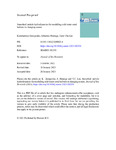Smoothed particle hydrodynamics for modelling cold-water coral habitats in changing oceans
| dc.contributor.author | Georgoulas, K | |
| dc.contributor.author | Hennige, S | |
| dc.contributor.author | Lee, Yeaw Chu | |
| dc.date.accessioned | 2023-02-06T16:37:11Z | |
| dc.date.available | 2023-02-06T16:37:11Z | |
| dc.date.issued | 2023-04 | |
| dc.identifier.issn | 1385-1101 | |
| dc.identifier.issn | 1873-1414 | |
| dc.identifier.other | 102358 | |
| dc.identifier.uri | http://hdl.handle.net/10026.1/20239 | |
| dc.description.abstract |
The importance of the growth, proliferation and longevity of reef-forming cold-water corals is paramount as they support various complex bio-diverse habitats and provide many essential ecosystem services. These cold-water coral reefs consist of layers of living coral tissue that grow on top of large masses of coral skeleton. Here, the Goldilocks Principle is used to simulate growth in optimal conditions and model how cold-water corals engineer their habitat to survive and prosper. A computational fluid dynamics model is created based on the Smoothed Particle Hydrodynamics method, a mesh-free Lagrangian numerical method. The SPH solver is written in the C++ programming language and parallelised with OpenMP to improve its efficiency and reduce the execution times. The solver is validated against analytical and numerical solutions and the growth model is then validated against in situ data of real cold-water coral colonies. The numerical results suggest that the longevity of cold-water corals depends on how well they can manage their energetic reserves when exposed to sub-optimal prey-catching conditions. | |
| dc.format.extent | 102358-102358 | |
| dc.language | en | |
| dc.language.iso | en | |
| dc.publisher | Elsevier BV | |
| dc.subject | Smoothed particle hydrodynamics | |
| dc.subject | Cold-water corals | |
| dc.subject | Coral growth model | |
| dc.subject | Coral energetic reserves | |
| dc.title | Smoothed particle hydrodynamics for modelling cold-water coral habitats in changing oceans | |
| dc.type | journal-article | |
| dc.type | Journal Article | |
| plymouth.author-url | https://www.webofscience.com/api/gateway?GWVersion=2&SrcApp=PARTNER_APP&SrcAuth=LinksAMR&KeyUT=WOS:000963999000001&DestLinkType=FullRecord&DestApp=ALL_WOS&UsrCustomerID=11bb513d99f797142bcfeffcc58ea008 | |
| plymouth.volume | 192 | |
| plymouth.publication-status | Published | |
| plymouth.journal | Journal of Sea Research | |
| dc.identifier.doi | 10.1016/j.seares.2023.102358 | |
| plymouth.organisational-group | /Plymouth | |
| plymouth.organisational-group | /Plymouth/Faculty of Science and Engineering | |
| plymouth.organisational-group | /Plymouth/Faculty of Science and Engineering/School of Engineering, Computing and Mathematics | |
| plymouth.organisational-group | /Plymouth/Users by role | |
| plymouth.organisational-group | /Plymouth/Users by role/Academics | |
| dcterms.dateAccepted | 2023-01-23 | |
| dc.rights.embargodate | 2023-2-8 | |
| dc.identifier.eissn | 1873-1414 | |
| dc.rights.embargoperiod | Not known | |
| rioxxterms.versionofrecord | 10.1016/j.seares.2023.102358 | |
| rioxxterms.licenseref.uri | http://www.rioxx.net/licenses/all-rights-reserved | |
| rioxxterms.type | Journal Article/Review |


